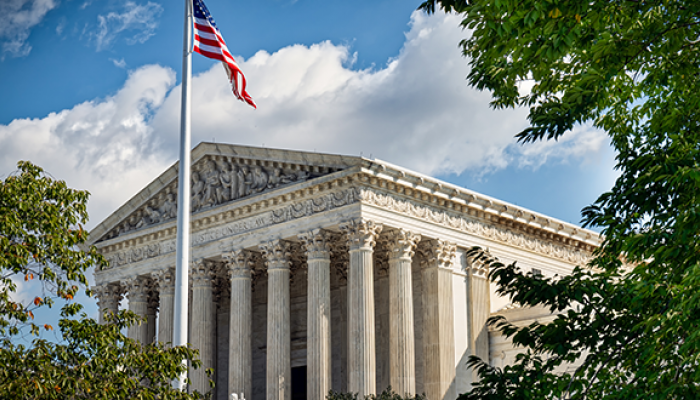Update February 20, 2019: The Supreme Court has ruled that the Excessive Fines Clause does apply to the states.
“Can we all just agree that the Excessive Fines Clause is incorporated against the states?” Supreme Court Justice Neil Gorsuch posed this question to the state of Indiana in the Timbs v. Indiana oral argument on Wednesday, expressing disbelief that someone would argue otherwise. Judge Gorsuch’s question provided substantial insight into how the Supreme Court will likely rule on whether or not the Eighth Amendment’s Excessive Fines Clause applies to states.
Timbs v. Indiana involves the use of civil asset forfeiture by states and localities. The petitioner, Tyson Timbs, used his recently-purchased Land Rover vehicle when buying and transporting a small amount of heroin. When Timbs pled guilty in 2015, the state of Indiana sought to take possession of his Land Rover, which he had purchased for $42,000. The trial court refused, saying that the forfeiture would be an unconstitutionally excessive fine under the Eighth Amendment. But the Supreme Court of Indiana reversed, explaining that the U.S. Supreme Court had not yet decided whether the Eighth Amendment prohibition against excessive fines applies to, or is “incorporated against,” the states.
The Brennan Center for Justice, together with allies from across the ideological spectrum including the Drug Policy Alliance and FreedomWorks, filed an amicus brief in Wednesday’s case arguing that the clause should be incorporated against the states. The brief discusses the modern experience with civil asset forfeiture and how it disproportionately affects low-income communities and communities of color, and argues that such fines are exactly what the Eight Amendment’s Excessive Fines Clause was meant to protect against. Based on Wednesday’s oral argument, the Supreme Court seems poised to adopt that position, too.
Clear signaling on whether the Excessive Fines Clause is incorporated against the states
Other Justices echoed Justice Gorsuch’s position that the Excessive Fines Clause is incorporated against the states. Justice Brett Kavanaugh asked Indiana’s Solicitor General whether there was any doubt that, by this point, the Bill of Rights was incorporated. Justice Sonia Sotomayor noted that the only way the state of Indiana could prevail “with a straight face” is if the Supreme Court were to overrule precedent. Justice Samuel Alito concurred, noting that Indiana was asking the Court to revert to a bygone era before the vast majority of the Bill of Rights was applied to the states in the 1940s.
The Justices gave a clear indication of how they may rule on the incorporation question. But Justice Elena Kagan pointed out that what incorporation means for individual rights is less clear. If the Supreme Court ultimately decides that the Excessive Fines Clause is incorporated against the states, the more difficult question remains: what exactly constitutes an excessive fine?
The Justices touched on a few issues central to this inquiry.
What counts as a fine?
The threshold question of whether the Excessive Fines Clause applies in any given case turns on whether the sanction is a “fine” — meaning a punitive or “partially punitive” sanction. Indiana’s Solicitor General attempted to argue that a civil asset forfeiture is not a fine, but the Court appeared unconvinced. The Supreme Court has previously ruled that civil asset forfeiture is punitive in nature — hence the skepticism from the bench.
But the determination of what counts as a “fine” has far-reaching consequences. In addition to civil asset forfeiture, states and localities assess various types of fines and user fees on criminal defendants. Whether these fines and user fees are subject to the Excessive Fines Clause remains an open question.
Should a person’s wealth factor into whether a fine is “excessive”?
In determining whether a fine is excessive, courts ask whether it is “grossly disproportionate” to the crime committed. Justices Stephen Breyer and Alito asked whether a person’s relative wealth should also factor into an excessive fine determination. This question is an important one, given that the criminal justice system, and the courts in particular, increasingly rely on funding from fines collected from low-income defendants. While these fines may not seem like a lot of money to some, they can cause profound harm to poorer individuals and their families — those most impacted by the criminal justice system.
What is a “disproportionate” fine?
The standard for determining whether a fine is excessive — if it’s “grossly disproportionate” to the crime committed — mirrors the standard for the Eighth Amendment’s Cruel and Unusual Punishment clause. As Justice Kagan noted, proving that a lengthy prison sentence constitutes cruel and unusual punishment is an extremely high standard to meet. For example, in Harmelin v. Michigan, the Court held that Harmelin’s life without parole sentence for cocaine possession was not cruel and unusual. Justice Kagan explained that if the courts make it equally difficult to prove Excessive Fine violations, it could have virtually no practical effect, even if the Court decides that the Excessive Fines Clause is incorporated against the states.
(Image: Shutterstock.com)
